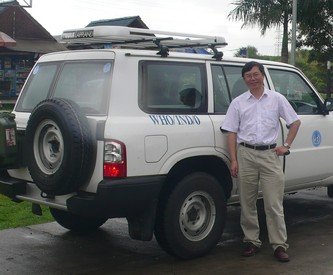A Breath of Fresh Air
When an infectious disease erupts, most people look to medical professionals for a solution. But the Faculty of Engineering has been demonstrating that their discipline can help to control the spread of infection, too.
When an infectious disease erupts, most people look to medical professionals for a solution. But the Faculty of Engineering has been demonstrating that their discipline can help to control the spread of infection, too.
The SARS (Severe Acute Respiratory Syndrome) outbreak in 2003 was their proving ground. The government and medical experts were perplexed about how the disease had spread within one complex, Amoy Gardens. They recruited members of the Department of Mechanical Engineering, who produced a plausible explanation based on engineering principles related to ventilation.
The experience led the engineers to further investigations and their results have had an impact around the world.
Led by Professor Li Yuguo, and working with experts from other disciplines, the team constructed a hospital room laboratory and measured how droplets dispersed, for instance when someone coughed and sneezed.
"We've come to understand the role played by all kinds of droplets – how they move, how they disperse, how they evaporate in the indoor environment," says Professor Li.
"In the past, guidelines on hospital environments were developed by medical doctors and infectious disease control people with very little input from engineers. The objective was to remove droplets but they assumed the droplets would be heavy and fall. Hence they put the ventilation exhaust in the lower part of the room."
His team showed that droplets can also disperse upwards and that ventilation at the top of the room was better at managing dispersion.
The findings have implications for a range of infectious diseases, such as avian flu and swine flu. The World Health Organisation has incorporated the findings into the ventilation chapter of its 2007 interim infection control guideline for healthcare settings as well as a 2009 guideline on pandemic influenza management.
The Indonesian Ministry of Health recruited Professor Li to review the design of avian flu isolation rooms in more than 20 hospitals, while Hong Kong's Centre for Health Protection asked him to run a training course for its staff. Professor Li and his colleagues have also trained about 1,500 infection control nurses and professionals from Hong Kong and other countries in the region.
"Hong Kong has done very well in this area. We lead the world at the moment," Professor Li says. "Engineers need to work together on this with microbiologists and epidemiologists and other medical professionals."
Professor Li was appointed a 2012 Distinguished Lecturer by the American Society of Heating, Refrigerating and Air Conditioning Engineers (ASHRAE), an international society focused on building technology, and he will give talks to its chapters around the world. His research was also part of the 2010 National Science and Technology Advance Award Second Prize.
Professor Li Yuguo received the Faculty Knowledge Exchange Award 2012 of the Faculty of Engineering for the "Ventilation for Better Infection Control in Hospitals" project.


